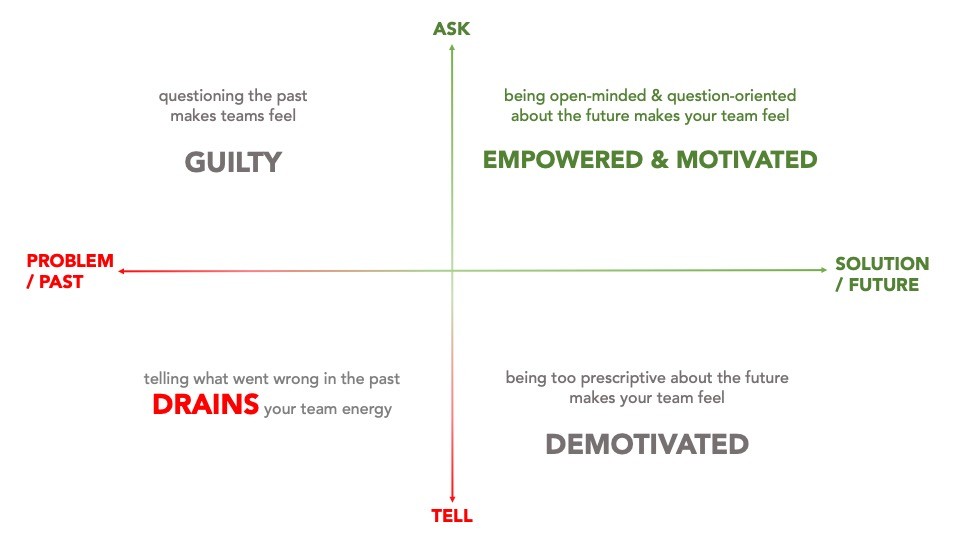In fact, we often rely on managerial techniques and intuitive practices that are increasingly ineffective. Especially with Millennials and Gen Z representatives, which have experienced much less criticism throughout their formative years compared to previous generations. That’s why most managers need to reconsider the list of things they intuitively and routinely do, such as:
Our first piece of advice is to stay positive. Most employees are driven by the prospect of receiving recognition at work by meeting the agreed objectives. Yet, they are often standing at the frontline of the business and coping with its day-to-day challenges. So, they need to know that the rear is not merely judging them but also supporting them. And the first line of support is listening, caring, and building a positive narrative.
That’s why it is paramount not to take good performance for granted, but to acknowledge it. This positive feedback will solidify the good habits in your employees. You wouldn’t want a good habit to go astray because of oversight on your end. To reinforce positive habits, it’s important to take the time to delve into the details of good and great performance to shed light on the practices and reflexes that make achievements come about.
Managers should limit negative feedback to instances when there is an imminent threat for the business or colleagues. So before criticising someone, ask yourself whether there is an immediate danger to be avoided? If not, pause. Take your time. While you mitigate your own emotions, try to consider the ones your colleague is going through. Emotions are a mental barrier preventing us from processing feedback adequately. It’s important to find the time and place when such emotions are minimal. Finding the right opportunity to share feedback is essential. Pick a moment in the week where business as usual runs a little slower.
When the timing is right, the second key to giving feedback that works is to put the recipient’s brain in the driver’s seat. As a business leader, you achieve that by asking questions as opposed to telling colleagues what to do. By doing so, you put yourself on the same equal footing as your colleague and you put yourself in a listening mode, which is an opportunity for colleagues to also provide feedback and demonstrate their problem-solving skills.
The third key to driving performance through feedback is to focus on solutions rather than problems. As often with motivation and performance, it’s all a question of perspective. Not all questions are equal. “Why didn’t you hit your targets?” will probably lead to a lengthy defensive plea with extensive details about why the targets were not reached.
“What do you need to hit your targets?” will lead to a completely different discussion that has probably more chances to lead to solutions. Focusing on solutions is a choice you can make in the moment. The only difference between “Why did this happen?” and “What shall we do about this?” is which question you choose to ask as a leader. It’s a discipline you can develop. Meanwhile, remember that “why” questions focusing on past problems will often generate a sense of guilt that will freeze their spontaneity and disable their creativity. In the visual, below, we have tried to summarise the impact your approach to feedback will have on your team.

“How” and “What” questions, on the other hand, are more open-ended and solution oriented. They will prompt employees to identify new habits that they could develop to bring required solutions closer. Allowing colleagues to share insights usually gives them pride and motivates them to turn them into realities.
But as a manager, your job is not just to ask the right questions. First, you should not overlook the fact that asking open-ended questions geared towards solutions will take people to the edge of their comfort zone. In fact, as a leader wanting to develop people and to improve their performance, you need to be comfortable with making people uncomfortable, at least for a while. Exploring something new is like dealing with uncertainty for some. It places them in a state of mild discomfort, frustration or fear. How can you deal with that? By evaluating the right amount of stretch and by letting them know that their discomfort, frustration, or fear is normal.
Then, once your colleagues have identified the way forward, your job as a leader will be to provide encouragement, support, and trust to ensure that they develop new habits. It’s pivotal to give LOTS of positive feedback as they try something new. And remember that encouragement must be specific to be impactful: it’s not just saying something vaguely positive, it’s about noticing what people do and how they make a difference and formulating it in an acknowledgement.
What should you do when people really mess up? First, manage your own emotions. Then, choose the right time and place. Ask permission to discuss the matter. Remind your interlocutor that the past is the past and cannot be changed and that you want to focus on the future.
Then, put your colleagues in the driving seat. Invite them to rate their performance: “How well did you perform on a scale of 1 to 10?”. Do not get dragged into the details or justifications, as going into the details of what went wrong will reinforce the habits that drove to the mess. Ask instead “what did you learn?”, and then ask how you can best help them to improve. You can also ask “what do you suggest we do?”.
As we conclude, bear in mind that feedback also hinges on the quality of the relationship with your colleagues.
Authenticity and sincerity can make a wealth of difference. If you really care about your team, it will be much more likely to accept and process your feedback. Now, we – at beez – will be happy to further develop your team management and leadership skills through dedicated coaching sessions 😉